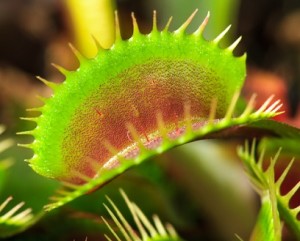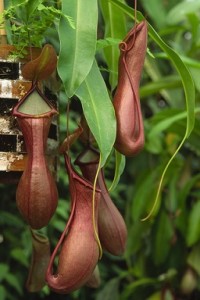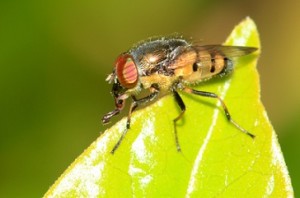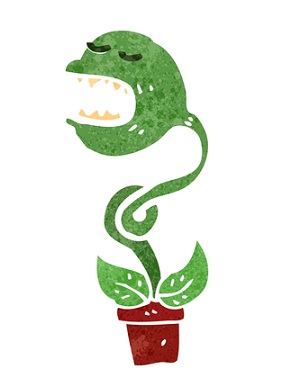
Carnivorous plants are so strange that they can trigger fear. But person-eating plants are the stuff of low-budget science fiction, not reality
Why Do Some Plants Consume Insects?
Here’s a situation I’ve run into many times. Me giving a presentation: “Plants are the base of the food chain on planet earth. Do plants eat animals, or do animals eat plants?”
Someone in audience: “What about the plants that eat insects?”
Okay, let’s figure out this question. What about these carnivorous plants? Do they upset the foundation of the food chain idea? And what lesson do they hold on whether you should eat meat?
SURPRISING FACTS ON CARNIVOROUS PLANTS
Plants need both energy and nutrients to survive and grow. All plants, carnivorous or not, get their energy from the sun. Using the process of photosynthesis in leaves, they convert sunlight into energy that is stored in chemical bonds. This energy is used both by plants for their own processes and by animals (which cannot directly harvest sunlight for energy and must rely on plants, either directly or indirectly).
Nutrients needed to build plant cells are mainly absorbed from soil through the plant’s root system.
This is where carnivorous plants are different. They live in extremely nutrient-poor soil (often in swamps and bogs), and gain an advantage by supplementing their nutrient supply by catching and digesting insects, and sometimes even larger prey – such as small frogs or rats. Nitrogen and phosphorus, both essential for plant growth, are the main nutrients that carnivorous plants seek from their prey.
Meat-eating plants always “hunt” with their leaves, which have evolved in several different ways to trap and digest insects and other animals. For example, pitcher plants have leaves folded into deep, slippery pools. Prey fall in, then can’t get out. In contrast, the Venus
flytrap uses hinged leaves that snap tightly shut when an insect crawls on them to capture their meaty meals.
Scientists have discovered about 600 species of carnivorous plants. Yet there are likely 300,000 to 400,000 total species of plants on earth. Put another way, this means 99.85% of all plants on earth are not carnivorous. Why is this true, when it would appear at first glance that catching prey is a smart way to get a big nitrogen boost, and hence a survival advantage?
The answer is that carnivorous plants pay a heavy price for their ability to eat animals. Much of the plant’s energy is diverted into building specialized leaves to trap bugs, and digestive enzymes to break the insects down and absorb them. Successful capture of prey is erratic and unreliable, just as it is for animal carnivores. The meat-eating plant thus spends a lot of energy for an unpredictable nutrient supply.
And it gets worse. The leaves of carnivorous plants, built around
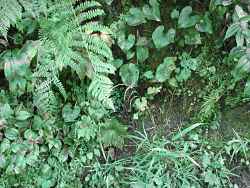
All plants, carnivorous or not, make their energy in their leaves through the process of photosynthesis
capturing insects, are not nearly as efficient at converting sunlight to energy as are the leaves of normal plants, which are designed for photosynthesis. As a result of this undependable nutrient supply and inefficient energy production, carnivorous plants grow extremely slowly and take years to reach maturity. Most do not get very big (none gets nearly big enough to eat a person, don’t worry). In good soil, carnivorous plants could not compete with normal plants.
CARNIVOROUS PLANTS SHOW YOU DON’T NEED MEAT
Why do plants of any kind need nitrogen? This question gets to the heart of the issue of whether carnivorous plants poke a hole in the theory that plants are the base of the food chain.
To unravel the answer, it’s important to have a basic understanding of what protein is. Amino acids are the building blocks of proteins, which are linked and folded chains of amino acids. The same twenty amino acids make up the proteins of all plants and animals on earth. Nitrogen is an essential element in amino acids. Hence, when there is a shortage of nitrogen, plants cannot make enough amino acids to grow.
Plants can and do manufacture all twenty amino acids needed for life. Humans and other animals manufacture some amino acids, but cannot make the “essential” one. These are the protein building blocks that take the most energy to assemble. In adult humans, there are eight essential amino acids that must come from plants in the diet (or from animals that ate plants).
To sum up, here is the flow of nitrogen (and amino acids) for carnivorous plants. A normal plant gets nitrogen from the soil and makes all twenty amino acids. An insect eats the plant and gets that plant’s amino acids. Then a carnivorous plant eats the bug. The insect is never the original source of the nitrogen. Instead, a normal plant is.
The fact that bugs eat plants, and carnivorous plants eat bugs, shows that animal and plant amino acids are interchangeable. In fact, they are identical.
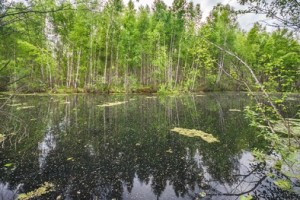
Swamps, with low nutrient soil, are prime habitat for carnivorous plants. These plants are often endangered by habitat loss and humans plucking them from their homes. If you find a carnivorous plant growing in nature, take a picture of it and let it be
The bottom line is that carnivorous plants are the exception that proves the rule that plants are the base of the food chain. You do not need animal foods for nutrition. Get your essential amino acids from the original plant source, not the animal middleman. Leave meat for cats, Venus flytraps, and pitcher plants.
If you enjoyed this post, you may want to test some of these delicious whole foods, plant-based recipes.
Intrigued? Now you can use our Whole Foods Blog Finder to target informative, fun postings on whole foods, plant-based diets. Quick information at no cost!
Blog posting by Janice Stanger, Ph.D. Janice authored The Perfect Formula Diet: How to Lose Weight and Get Healthy Now With Six Kinds of Whole Foods, a book that shows you how to thrive on a whole foods, plant-based diet. Janice will one day visit a bog to see these curious carnivorous plants in action.
Tags: amino acid, carnivorous plant, insect eating plant, pitcher plant, protein, Venus flytrap, whole foods, whole foods plant-based diet
